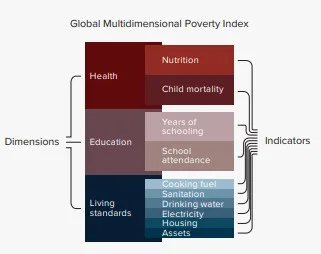Syllabus: GS2/ Governance
Context
- The 2024 Global Multidimensional Poverty Index, is published with the theme of Poverty Amid Conflict.
About Global Multidimensional Poverty Index
- MPI is published annually by the UN Development Programme (UNDP) and the Oxford Poverty and Human Development Initiative.
- The index utilizes 10 indicators across these three dimensions.
- If a household is deprived in one-third or more of these indicators, it is considered multidimensionally poor.

Key Findings
- Across 112 countries and 6.3 billion people, 1.1 billion people (18.3 percent) live in acute multidimensional poverty.
- Poor people live in rural areas: 962 million (83.7 percent) live in rural areas.
- Around 70.7 percent of all poor people live in rural areas of Sub- Saharan Africa (463 million) and South Asia (350 million).
- The five countries with the largest number of people living in poverty are India (234 million), Pakistan (93 million), Ethiopia (86 million), Nigeria (74 million) and the Democratic Republic of the Congo (66 million).
- Together, these five countries account for nearly half (48.1 percent) of the 1.1 billion poor people.
- Approximately 584 million people under 18 are living in extreme poverty, making up 27.9% of all children globally, compared to 13.5% of adults.
- Poverty in conflicted regions: The report noted that 2023 witnessed more conflicts than at any time since World War II causing displacement of over 117 million people.
- Nearly 40% of the 1.1 billion people live in poverty, approximately 455 million, are situated in countries experiencing conflict.
Reasons for India’s poor performance
- Regional Disparities: Rural poverty rates remain high due to inadequate infrastructure, poor service delivery, and limited economic opportunities outside agriculture.
- Poor nutrition: India struggles with severe malnutrition, particularly among children.
- Quality of education: The quality of education in many government-run schools is poor, leading to insufficient learning outcomes.
- Water and sanitation: Poor access to safe drinking water and inadequate sanitation, particularly in rural areas, continues to push many households into multidimensional poverty.
- Economic setbacks: The COVID-19 pandemic severely disrupted India’s economy, leading to job losses, reduced incomes, and increased vulnerabilities for millions of households.
Government Steps for Poverty alleviation
- National Food Security Act (NFSA), 2013: It gives legal entitlement to 67% of the population (75% in rural areas and 50% in urban areas) to receive highly subsidized foodgrains.
- Pradhan Mantri Ujjwala Yojana (PMUY) (2016): This initiative was introduced to provide LPG (liquefied petroleum gas) connections to women belonging to Below Poverty Line (BPL) families.
- Ayushman Bharat scheme: It offers health insurance coverage of up to ₹5 lakh per family per year to shield beneficiaries from the financial burden of expensive medical treatments, thereby preventing them from falling deeper into poverty due to healthcare costs.
- National Nutrition Mission (POSHAN Abhiyaan): Launched in 2018, the mission aims to reduce malnutrition by focusing on stunting, undernutrition, and anemia, especially among children, adolescent girls, pregnant women, and lactating mothers.
- Right to Education Act (RTE): The RTE Act, enacted in 2009, provides free and compulsory education for children between 6 and 14 years.
- Swachh Bharat Mission: The mission aims to achieve universal sanitation coverage by constructing toilets and promoting cleanliness.
Way Ahead
- India has made significant strides in poverty reduction through various initiatives but there is room for further improvement.
- Promoting sustainable livelihoods, improving the quality of service delivery, and leveraging digital solutions for better implementation will ensure that multidimen
- sional poverty continues to decline.
Source: UNDP
Previous article
On the Exception to Marital Rape